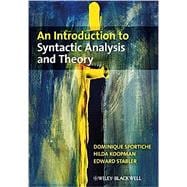An Introduction to Syntactic Analysis and Theory offers beginning students a comprehensive overview of and introduction to our current understanding of the rules and principles that govern the syntax of natural languages.
- Includes numerous pedagogical features such as 'practice' boxes and sidebars, designed to facilitate understanding of both the 'hows' and the 'whys' of sentence structure
- Guides readers through syntactic and morphological structures in a progressive manner
- Takes the mystery out of one of the most crucial aspects of the workings of language – the principles and processes behind the structure of sentences
- Ideal for students with minimal knowledge of current syntactic research, it progresses in theoretical difficulty from basic ideas and theories to more complex and advanced, up to date concepts in syntactic theory








